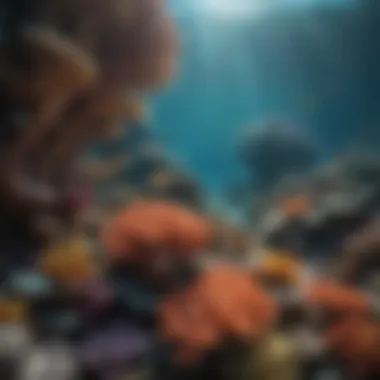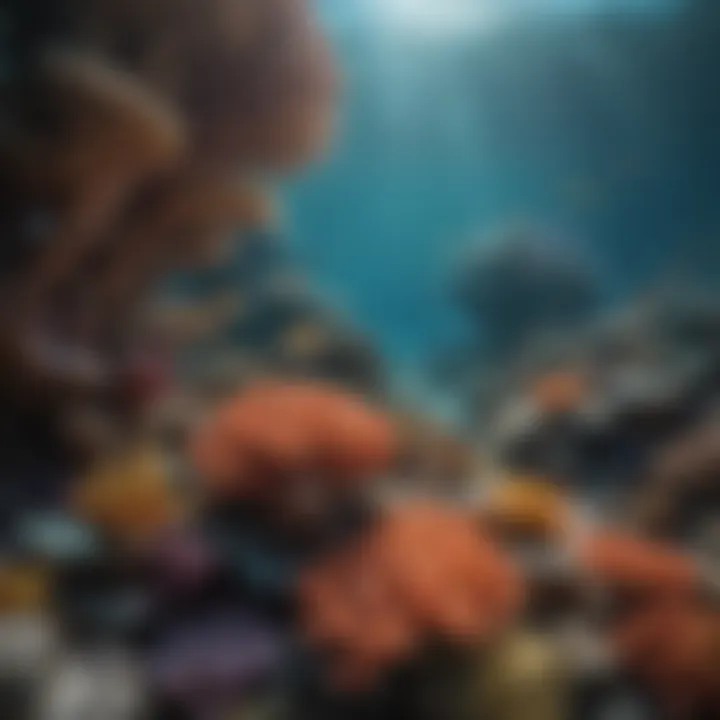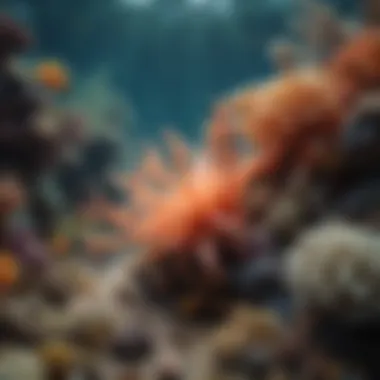Coral Reefs: Vital Ecosystems for Biodiversity and Economy


Intro
Coral reefs are intricate ecosystems that play several crucial roles in marine environments. They are home to a wide variety of species, contributing significantly to global biodiversity. The ecological functions of coral reefs extend beyond mere habitat; they serve as natural barriers protecting coastlines from erosion and storm damage. Furthermore, coral reefs act as indicators of marine environmental health, offering insights into the sustainability of the oceans.
Research Overview
Coral reefs are often referred to as the "rainforests of the sea" due to their unparalleled biodiversity. Recent studies highlight their importance in supporting approximately 25% of all marine species, despite covering only about 0.1% of the ocean's surface. This section delves into the existing literature and recent findings about coral reefs.
Summary of Key Findings
The primary findings indicate that coral reefs:
- Enhance Biodiversity: They are critical habitats for numerous marine organisms, providing food and shelter.
- Provide Coastal Protection: Their structures reduce wave energy, protecting coastal areas from erosion.
- Serve as Economic Resources: Coral reefs contribute significantly to fisheries and tourism, underscoring their role in local economies.
- Indicate Environmental Changes: The health of coral reefs is closely linked to environmental factors, making them useful for indicating broader ecological shifts.
Background and Context
Coral reefs have existed for over 500 million years. They have evolved complex relationships with the organisms living within them, such as fish, mollusks, and various algae. Unfortunately, these ecosystems face numerous threats, including climate change, pollution, and overfishing. Understanding these aspects is vital for advocating effective conservation strategies.
Methodology
To explore the ecological importance of coral reefs, scientists employ various methodologies that encompass both qualitative and quantitative approaches.
Experimental Design
Research often involves field studies, where scientists observe the interactions between coral species and their environment. Controlled laboratory experiments may also be conducted to assess the responses of corals to stressors like temperature and acidity changes.
Data Collection Techniques
Data is gathered through:
- Biodiversity Surveys: Researchers document the variety and abundance of species associated with coral reefs.
- Water Quality Measurements: Analyzing water samples helps in understanding the health of the ecosystem.
- Remote Sensing: Technology is utilized to monitor reef health and changes in structure at large scales.
"The sustainability of coral reefs is vital for ecological balance and human livelihoods."
In sum, coral reefs fundamentally contribute to ecological stability and human economies. Their decline would not only affect marine life but also have serious consequences for coastlines and local communities.
Intro to Coral Reefs
Coral reefs are not just vibrant underwater structures; they are vital ecosystems teeming with life. Their significance extends far beyond their beauty, impacting various marine species and human communities alike. Understanding what coral reefs are, their importance in ecological balance, and their historical context lays the foundation for comprehending the broader implications of their health and survival.
In this section, we will explore the definition of coral reefs and examine a historical overview that highlights their long-standing presence in marine environments. Recognizing the intricate relationships within coral ecosystems is crucial for appreciating their resilience and the threats they now face.
Definition of Coral Reefs
Coral reefs are raised underwater structures formed by colonies of tiny animals known as coral polyps. These polyps secrete calcium carbonate, gradually creating complex reef structures. There are several types of coral reefs, mainly including fringing reefs, barrier reefs, and atolls. Each type plays a unique role in the marine environment, providing habitat and shelter for countless marine organisms.
Coral reefs are categorized as biodiversity hotspots, because they support a remarkable array of species. This diversity comprises not just corals but also fish, mollusks, sea turtles, and many other marine creatures. Their value is not only ecological; they also have significant economic implications, particularly for local and global fisheries.
Historical Overview
Historically, coral reefs have existed for millions of years. The oldest known reefs date back over 500 million years. Throughout history, they have adapted to changing environmental conditions. Today, coral reefs are often described as the rainforests of the sea. Scientists have documented thousands of species that inhabit these delicate structures and their ecological functions.
Coral reefs have been revered by many cultures, serving as sources of food and materials. However, human activity has accelerated their decline in recent decades. Today, understanding their history is critical in addressing the contemporary challenges they face, such as climate change, pollution, and overfishing.
"Coral reefs are essential for sustaining marine life and protecting coastlines, yet they are incredibly fragile. The historical context of their development is imperative for conservation efforts."
As we delve deeper into the roles of coral reefs in the following sections, it becomes evident that preserving these ecosystems is not just a matter of environmental concern but a necessity for future generations.
Ecological Functions of Coral Reefs
Coral reefs serve multiple ecological functions that are crucial in maintaining the health of marine ecosystems. These vibrant structures are not just beautiful; they play vital roles in biodiversity, habitat creation, and nutrient cycling. Coral reefs support a wide range of marine species, contributing to the overall balance of oceanic life. Their ecological importance cannot be overstated, as they provide services that benefit marine and human life alike.
Biodiversity Hotspots
Coral reefs are often considered biodiversity hotspots, housing an astonishing variety of marine organisms. The rich diversity of life found in these ecosystems is attributed to their complex structure and the various niches available. This section will delve into two major aspects of biodiversity on coral reefs: species richness and endemism.
Species Richness
Species richness refers to the number of different species present in a given area. Coral reefs are known for having one of the highest levels of species richness on the planet. Various factors contribute to this phenomenon. One significant aspect is the intricate environment created by the coral structures, which provides numerous habitats for different marine species.
The key characteristic of species richness in coral reefs is its variability. This ecosystem harbors thousands of species, including fish, invertebrates, algae, and larger predators. Their diversity contributes to the overall health and resilience of the ecosystem. A high level of species richness can lead to increased stability, as diverse ecosystems are generally more capable of withstanding environmental changes.


However, the unique feature of this species richness often comes at a cost. As more species exist, they create complex interactions that can be sensitive to changes. For instance, the loss of any single species might disrupt the balance, affecting many other species within the ecosystem.
Endemism
Endemism refers to species that are native to a specific geographic area and not found elsewhere. Coral reefs are also home to a number of endemic species. This phenomenon adds another layer of significance to coral ecosystems. Endemic species often have specialized habitats and are adapted to the conditions specific to their environment.
The characteristic aspect of endemism in coral reefs is that it reflects both the evolutionary processes and the geological history of the regions. Many endemic species contribute to the unique identities of various reefs, enhancing their ecological value. Such species can be indicators of the health and diversity of these ecosystems.
However, the unique aspect of endemic species makes them particularly vulnerable to environmental changes. If conditions alter, such as in the case of climate change or pollution, these species might not survive. The extinction of endemic species can lead to loss of diversity, making the ecosystem less resilient overall.
Shelter and Habitat Provision
Coral reefs are crucial in providing shelter and habitat for a multitude of marine life. Their structures create safe spaces for organisms to live, reproduce, and thrive. The significance of this role is immense and includes two primary aspects: the role for marine life and the provision of breeding grounds.
Role for Marine Life
The role of coral reefs as a shelter for marine life is one of their most vital functions. Many species depend on the coral structures for protection from predators and harsh environmental conditions. The three-dimensional complexity of reef structures offers numerous crevices and hiding places for fish and invertebrates.
What makes this aspect particularly valuable is that it allows for greater survival rates among juvenile fish, leading to healthier adult populations. This unique feature of providing shelter is indispensable for maintaining the balance of marine ecosystems.
While this sheltering function is beneficial, it also comes with certain disadvantages. If the coral reef is disturbed or degraded, the organisms dependent on these shelters lose their homes. This can lead to a significant decline in marine populations, impacting overall biodiversity.
Breeding Grounds
Coral reefs also function as essential breeding grounds for many marine species. Many fish and invertebrates return to reefs to spawn. The sheltered environment helps protect the eggs and newly hatched organisms from overwhelming predators. Hence, coral reefs play a crucial role in the life cycles of these species.
A critical characteristic of breeding grounds in coral reefs is the timing of spawning events. These often occur in synchronization with lunar cycles, showcasing an intricate relationship between the reef's ecosystem and environmental factors. The unique feature of using these grounds for breeding can positively influence population dynamics, aiding in sustaining marine life.
However, breeding grounds can be highly affected by environmental changes. Pollution and climate change can disrupt these spawning events, jeopardizing the reproductive success of species. Without healthy breeding grounds, the long-term viability of marine populations becomes uncertain.
Coral reefs are irreplaceable habitats that support diverse species and provide ecological functions critical for ocean health.
Coral Reefs in Carbon Cycling
Coral reefs have an essential role in the global carbon cycle, influencing not only marine ecosystems but also the atmosphere. Their capacity to absorb carbon dioxide is significant, and it extends beyond the confines of marine life. As this section unfolds, the mechanisms of carbon dioxide absorption by coral reefs and their broader impact on global carbon processes will be examined.
Carbon Dioxide Absorption
Coral reefs absorb carbon dioxide through various processes, primarily through photosynthesis by symbiotic algae known as zooxanthellae. These algae live within the coral tissues and use sunlight for photosynthesis, converting carbon dioxide into oxygen and organic compounds. This phenomenon not only supplies energy for the coral but also decreases the concentration of carbon dioxide in water, thus mitigating ocean acidification.
Furthermore, when corals produce calcium carbonate to build their structures, they sequester carbon in the form of solid matter. This calcification process is integral to the reef's growth and longevity. Establishing a healthy reef ecosystem enables greater absorption of carbon dioxide. It is thus vital to protect these ecosystems from threats like climate change, as their decline can diminish this critical function.
Impact on Global Carbon Cycle
The interaction between coral reefs and the global carbon cycle is profound. Coral reefs function as natural sinks, capturing and storing significant amounts of carbon. However, their role is not limited to carbon storage; they also affect the distribution and cycling of carbon in oceans.
When coral reefs are stressed, such as during bleaching events, their ability to absorb carbon dioxide diminishes. This situation can lead to increased levels of carbon dioxide in the atmosphere, exacerbating global warming. Moreover, loss of reef structures results in less available habitat for diverse marine species, negatively affecting biodiversity, which plays a role in the overall stability of the carbon cycle.
Therefore, safeguarding coral reefs is not just about conserving marine life; it is critical for maintaining the integrity of the global carbon cycle. Recognizing their importance can inspire conservation efforts and highlight the interconnectedness of global ecosystems.
"Coral reefs as carbon sinks play a pivotal role in mitigating climate change while promoting marine biodiversity."
Coral Reefs and Coastal Protection
Coral reefs play a crucial role in coastal protection, serving as natural barriers that significantly mitigate the impact of environmental threats. These vibrant ecosystems help maintain the structural integrity of coastlines while enhancing marine biodiversity. Understanding this importance is vital for developing effective conservation strategies and policies.
Natural Barriers Against Erosion
Coral reefs act as natural barriers against coastal erosion. They absorb wave energy, reducing the force of waves before they reach the shoreline. This process prevents soil and sand from being washed away, protecting coastal habitats.
Research has shown that areas with healthy coral reefs experience much less erosion than those without. According to studies, reefs reduce wave height by up to 97% in some cases. Consequently, this can lead to stable beaches and protect coastal infrastructure.
However, the effectiveness of coral reefs as erosion barriers can be compromised. Activities such as coastal development, reef damage from human interaction, and pollution threaten their health. When coral reefs degrade, the protective capacity is diminished, thereby directly increasing the vulnerability of coastal areas to erosion.
Mitigation of Storm Surges
In addition to preventing erosion, coral reefs also play a significant role in mitigating storm surges. Storm surges are upward sea levels caused by tropical storms and hurricanes, often leading to devastating floods in coastal areas. Healthy coral reefs can reduce the height and energy of storm waves, acting as a buffer against these natural disasters.
A recent study highlights the ability of coral reefs to lower storm surge heights by approximately 30%. This reduction is crucial for protecting coastal communities and infrastructure from flood damage. As sea levels rise due to climate change, the ability of coral reefs to function as a protective barrier becomes increasingly important.
It’s critical to recognize the interconnectedness of reef health and coastal protection. Conservation efforts not only help protect the biodiversity within coral systems but also emphasize their role in safeguarding coastlines against extreme weather events.


"The loss of coral reefs can lead to severe consequences, not just for marine life, but also for the human communities dependent on these ecosystems for protection."
Therefore, strategies that promote coral reef health, such as the establishment of Marine Protected Areas and sustainable fishing practices, need to be prioritized. This ensures ongoing protection for coastal regions while securing the ecological balance that has endured for millennia.
Human Dependence on Coral Reefs
Coral reefs play a critical role in sustaining both marine ecosystems and human economies. These vibrant and diverse habitats provide substantial benefits, influencing not only the health of our oceans but also the livelihoods of millions of people worldwide. Recognizing the importance of coral reefs is essential for promoting their conservation and understanding their ecological significance.
Fisheries and Livelihoods
Commercial Fisheries
Commercial fisheries depend heavily on the diverse array of species found in coral reef ecosystems. These fish are a vital source of protein for many communities and contribute significantly to the global seafood economy. The unique habitats offered by coral reefs support various commercially valuable species such as grouper and snapper, which have high market demand.
The character of commercial fishing varies greatly across regions, often dictated by local regulations and environmental conditions. This industry is beneficial as it supports jobs and provides income for countless families. However, overfishing poses a significant threat, potentially leading to ecological imbalance and depletion of species. Addressing sustainability is key to ensuring that commercial fisheries can thrive while preserving coral ecosystems.
Subsistence Fishing
Subsistence fishing is a practice primarily utilized by local communities relying on coral reefs for direct sustenance. Unlike commercial fisheries, which focus on profit, subsistence fishing is about survival. Local fishers harvest species needed for their families, making it crucial for food security in many coastal regions.
The main characteristic of subsistence fishing is its low impact on reef ecosystems, as it tends to involve smaller-scale practices. Yet, challenges exist, especially with the increasing population pressures and environmental changes that affect fish stocks. Recognizing and supporting these communities is vital, as their traditional practices often align with sustainable reef management.
Tourism and Recreation
Ecotourism
Ecotourism surrounding coral reefs offers an avenue for conservation and economic support. This responsible form of travel aims to benefit both the environment and local communities, attracting visitors who wish to experience the beauty and biodiversity of coral reefs. Ecotourism contributes to funding conservation efforts and raising awareness about the threats faced by these ecosystems.
A notable feature of ecotourism is its focus on education and sustainable practices. Tour operators are increasingly adopting strategies to minimize ecological footprints. This burgeoning sector presents advantages, such as creating jobs and preserving natural resources. However, it also has disadvantages; if not properly managed, increased foot traffic can lead to degradation of delicate coral environments.
Recreational Activities
Recreational activities, including snorkeling and diving, draw millions to coral reefs worldwide. These pursuits are significant for enhancing public awareness about the importance of marine conservation. They also stimulate local economies, as tourism-related businesses thrive on the influx of visitors.
A key characteristic of recreational activities is their ability to foster a connection between people and aquatic environments. However, concerns about reef damage from careless tourism practices arise. Sustainable guidelines and responsible behavior from visitors are crucial to safeguard these ecosystems for future generations.
"Coral reefs symbolize not just natural wonders, but also a lifeline for communities and economies dependent on their health."
Threats to Coral Reef Ecosystems
Coral reefs face a multitude of threats that endanger their survival and health. Understanding these threats is essential for recognizing the crucial role reefs play in marine ecosystems, human livelihoods, and overall environmental stability. Factors such as climate change, pollution, and unsustainable fishing practices contribute to the decline of these vibrant ecosystems.
Climate Change
Temperature Increases
Temperature increases pose a significant threat to coral reefs. As global temperatures rise due to climate change, coral bleaching events become more frequent. Coral bleaching occurs when corals expel the symbiotic algae, zooxanthellae, that provide them with nutrients and color. This loss can lead to starvation of corals and increased vulnerability to disease.
The key characteristic of temperature increases is their direct impact on coral health and resilience. This situation makes it a central focus for this article. Moreover, many coral species have specific temperature ranges that facilitate their growth and reproduction. When temperatures exceed these ranges, it disrupts vital ecological functions. The advantage of highlighting temperature increases is to create awareness about the fragility of coral systems under changing climate.
Ocean Acidification
Ocean acidification results from increased carbon dioxide levels in the atmosphere, which dissolves in ocean waters, leading to a decrease in pH. This older term describes a process that affects both marine ecosystems and coral reefs. The problem with ocean acidification is that it hinders the ability of corals to build their calcium carbonate structures. This affects their growth and increases susceptibility to erosion.
This feature of ocean acidification is critical as it illustrates the interconnectivity of atmospheric conditions and marine health. Discussing acidification is vital for this article, given the ongoing shifts in global ocean chemistry. The advantages of addressing ocean acidification include fostering actions to mitigate carbon emissions and protect marine environments.
Pollution
Land-Based Sources
Land-based sources of pollution, such as agricultural runoff, sewage discharge, and plastic waste, significantly degrade coral reef ecosystems. Nutrient loading from fertilizers can lead to algal blooms that smother corals. This process diminishes their ability to receive sunlight, effectively starving them.
One key characteristic of land-based pollution is its proximity to coral reefs. This aspect makes it a relevant topic for this article, as many reefs are located near populated coastal areas. The unique feature of land-based pollution is its diverse nature; it combines both chemical and physical elements that can harm marine life. The disadvantage of this pollution is that it often goes unnoticed until significant damage has occurred.
Marine Debris
Marine debris, consisting of plastic, metals, and other waste, poses a major threat to coral reefs. Debris can cause physical harm to corals, leading to injury or even mortality. Marine debris also introduces toxic substances into the marine environment, further threatening reef health.
A critical aspect of marine debris is its persistence in ocean environments. This characteristic raises the significance of the issue in this article. The unique quality of marine debris lies in its ability to accumulate over time, causing long-term ecological harm. Reducing marine debris can improve overall marine health, but solutions require collective efforts from individuals, communities, and regulations.
Overfishing and Unsustainable Practices


Overfishing and unsustainable fishing practices threaten coral reef ecosystems by depleting fish populations and disrupting the delicate balance of marine food webs. This not only affects the species of fish but also other organisms that rely on them for survival. Sustainable practices, such as regulated fishing quotas and protected areas, are essential for maintaining the health of these ecosystems.
Conservation Strategies for Coral Reefs
Conservation strategies for coral reefs are vital in ensuring the longevity and health of these complex ecosystems. Given the threats posed by climate change, pollution, and overfishing, strategic efforts are necessary. These strategies can lead to not only the preservation of coral reefs but also to the continued benefits they provide to marine biodiversity and human communities. The focus of effective conservation includes establishing protected areas, engaging local communities, and employing restoration techniques. Each of these conservation strategies holds significant promise as a means to halt the decline of coral reefs and foster recovery.
Marine Protected Areas
Marine Protected Areas (MPAs) represent a cornerstone of coral reef conservation strategies. These designated zones limit human activity to safeguard marine environments.
Benefits of MPAs
One of the clear benefits of MPAs is the increase in fish populations within protected zones. Without the pressure from fishing, some fish species can rebound robustly. This increased biomass can help maintain the health of surrounding areas, benefiting both biodiversity and fisheries. MPAs also protect critical habitats from destructive activity like bottom trawling, which can devastate coral structures.
In addition, MPAs can enhance ecotourism. Healthy, vibrant reefs attract tourists and can lead to economic benefits for local communities. The key characteristic of MPAs lies in their ability to create safe havens for marine life, thus contributing to the overall resilience of coral reefs.
However, there are disadvantages. Not all MPAs are equally effective, and some may not be enforced properly. Moreover, if surrounding areas continue to face degradation from other human activities, the efforts within MPAs may not be sufficient.
Challenges Facing MPAs
Despite their potential, challenges confront the establishment and management of MPAs. Many regions that would benefit from protection lack support or funding. In some cases, existing MPAs might not have clear boundaries or enforcement mechanisms, compromising their effectiveness.
Local community engagement is essential to overcome these challenges. If communities are not included in the decision-making, resistance to MPAs can emerge. The annual cost of maintaining these areas can also be high, diverting attention from other crucial conservation activities.
Community Engagement and Education
Community engagement and education form the backbone of successful conservation efforts. By involving local populations in planning and management, conservation measures become more effective. Education helps raise awareness about the ecological importance of coral reefs and their fragile state. Programs that promote stewardship can lead to better conservation outcomes and foster a sense of responsibility towards marine habitats.
Restoration Techniques
Restoration techniques play an essential role in coral reef recovery. In the face of environmental degradation, proactive measures focusing on restoring damaged or declining reefs are necessary. Two significant methods are coral gardening and transplantation methods.
Coral Gardening
Coral gardening is a strategy where fragments of healthy coral are grown in nurseries. This method allows for the grow of coral that can later be replanted in degraded areas. The unique feature of coral gardening is its ability to enhance genetic diversity and resilience among coral populations.
The advantages include relatively low cost and the possibility of fostering community involvement. However, not all species thrive in a gardening setup, and the method is time-consuming.
Transplantation Methods
Transplantation methods involve moving coral from one area to another, typically from healthy areas to damaged reefs. This method can help in quickly repopulating areas where coral is extinct or severely reduced. The key characteristic lies in its ability to restore coral cover in a relatively short timeframe. However, the success of transplantation varies significantly depending on the environmental conditions and species adaptability.
Future Prospects for Coral Reefs
Future prospects for coral reefs are of increasing importance. These ecosystems face numerous threats, yet they also present opportunities for innovative solutions. Understanding what lies ahead for coral reefs is essential for scientists, conservationists, and policy makers alike. The health of these reefs directly impacts biodiversity, coastal protection, and the economy. Therefore, advancing our understanding in this field can yield benefits not just for marine life but for human communities that rely on these ecosystems.
Research and Monitoring
Research and monitoring are fundamental to ensuring the survival of coral reefs. Continuous study helps to track changes in reef health and identify stressors early. Scientists use various methods, including underwater surveys and remote sensing, to gather data about coral cover and species diversity. The collected information is vital for formulating effective conservation strategies. Regular monitoring can reveal how different reefs respond to environmental changes, such as rising temperatures or pollution. By pinpointing the most vulnerable areas, resources can be allocated more effectively to protect these critical habitats.
Innovative Conservation Approaches
Biotechnological Interventions
Biotechnological interventions represent a promising avenue for coral reef preservation. These strategies include genetic engineering and selective breeding to enhance coral resilience. By identifying and cultivating heat-resistant coral strains, researchers aim to restore damaged reefs more effectively. This method focuses on the crucial characteristic of enhancing coral survival in warmer waters. The popularity of biotechnological solutions stems from their potential to significantly increase reef resilience amidst climate change. However, this approach carries challenges, such as ethical considerations and the need for thorough testing to ensure ecological balance is not disrupted.
Adaptive Management Practices
Adaptive management practices also highlight the future prospects for coral reefs. This approach involves adjusting management strategies based on monitoring results and evolving scientific understanding. A key characteristic of adaptive management is its flexibility. Such practices have become favored because they allow for responsive decision-making in the face of new data concerning reef ecosystems. Unique features of adaptive management include stakeholder involvement and ongoing research integration. This method can bring both advantages and disadvantages. One advantage is the capacity to address issues as they arise, but ongoing funding and commitment from various stakeholders are essential for its success.
"Effective conservation of coral reefs necessitates embracing both technological advancements and adaptive strategies to tackle the unprecedented challenges they face."
Culmination
The conclusion of this article encapsulates the multifaceted significance of coral reefs in our planet's ecosystems. These structures are not just beautiful underwater landscapes; they serve critical roles that extend beyond their immediate surroundings. In recognizing the ecological importance of coral reefs, we acknowledge their functions in maintaining biodiversity, supporting fisheries, providing coastal protection, and indicating environmental health.
Summary of Ecological Importance
Coral reefs are often referred to as the "rainforests of the sea" for their incredible biodiversity. They house thousands of marine species, many of which are not found anywhere else. This species richness contributes to the overall health of marine ecosystems. Furthermore, the interdependent relationships among species in these environments enhance resilience against changes.
Through their intricate structures, coral reefs offer shelter and breeding grounds for various marine life. They stabilize coastlines, protect shorelines from erosion, and mitigate the impact of storm surges. Their contribution to carbon cycling plays a vital role in global climate regulation by absorbing carbon dioxide.
Call for Action
The urgency to take action is paramount. It is vital to advocate for sustainable practices that protect coral reefs from the numerous threats they face. Current conservation strategies must not only focus on establishing marine protected areas, but also on promoting community engagement. Education about the importance of coral ecosystems is essential for fostering greater awareness and responsibility.
We must support and invest in innovative approaches to conservation and restoration. The integration of biotechnology and adaptive management can be crucial in reviving damaged reefs. Each individual can contribute, whether through responsible tourism, reducing plastic waste, or supporting local conservation initiatives. The future of coral reefs hinges on our ability to act decisively and thoughtfully.







